User:Gibmetal77/List of World Heritage Sites visited
Finand[edit]
| Name | Image | Location | Community | Period | UNESCO data | Description | Ref(s) |
|---|---|---|---|---|---|---|---|
| Fortress of Suomenlinna | 
|
Helsinki, 60°8′50″N 24°59′14″E / 60.14722°N 24.98722°E |
Cultural: (iv) |
—
|
1991 | Built in the second half of the 18th century by Sweden on a group of islands located at the entrance of Helsinki's harbour, this fortress is an especially interesting example of European military architecture of the time. |
}
Gibraltar[edit]
- Gorham's Cave Complex - 2016
Germany[edit]
- Museumsinsel (Museum Island), Berlin
Holy See[edit]
- Historic Centre of Rome, the Properties of the Holy See in Rome Enjoying Extraterritorial Rights and Basilica of Saint Paul Outside the Walls - transboundary property, shared with Italy — 1980, 1990
- Vatican City — 1984
Iceland[edit]
| Name | Image | Location | Community | Period | UNESCO data | Description | Ref(s) |
|---|---|---|---|---|---|---|---|
| Þingvellir National Park | Bláskógabyggð, 64°15′14″N 21°2′14″W / 64.25389°N 21.03722°W |
Cultural: (iii), (vi) |
9,270 (22,900) | 2004 | Þingvellir (Thingvellir) is the National Park where the Althing, an open-air assembly representing the whole of Iceland, was established in 930 and continued to meet until 1798. Over two weeks a year, the assembly set laws – seen as a covenant between free men – and settled disputes. The Althing has deep historical and symbolic associations for the people of Iceland. The property includes the Þingvellir National Park and the remains of the Althing itself: fragments of around 50 booths built from turf and stone. Remains from the 10th century are thought to be buried underground. The site also includes remains of agricultural use from the 18th and 19th centuries. The park shows evidence of the way the landscape was husbanded over 1,000 years. |
Italy[edit]
- Historic Centre of Rome, the Properties of the Holy See in that City enjoying extraterritorial rights, and Basilica of Saint Paul Outside the Walls; transboundary property, shared with the Holy See — 1980, 1990
- Archaeological Areas of Pompeii, Herculaneum and Torre Annunziata - 1997
- Historic Centre of Naples - 1995
- Historic Centre of Florence - 1982
Malta[edit]
- City of Valletta — 1980
- Megalithic Temples of Malta (seven objects):
- Ġgantija 1 (in Xagħra, Gozo) - 1980
- Ġgantija 2 (in Xagħra, Gozo) - 1980
- Ħaġar Qim (in Qrendi) - 1992
- Mnajdra (in Qrendi) - 1992
- Ta'Hagrat Temples (in Mġarr) - 1992
- Skorba Temples (in Żebbiegħ) - 1992
- Tarxien Temples (in Tarxien) - 1992
Netherlands[edit]
- Seventeenth-Century Canal Ring Area of Amsterdam inside the Singelgracht
Spain[edit]
| Name | Image | Location | Community | Period | UNESCO data | Description | Ref(s) |
|---|---|---|---|---|---|---|---|
| Alhambra, Generalife and Albayzín | 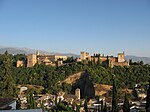
|
Granada | Andalusia | 14th century | 314; 1984, 1994 (extended); i, iii, iv | The three sites are remnants of the Moorish influence in southern Spain. The fortress Alhambra and the palace Generalife were built by the rulers of the Emirate of Granada. The Albayzín district contains examples of the Moorish vernacular architecture and was added to the listing in 1994.[3] | |
| Burgos Cathedral | 
|
Burgos | Castile and León | 13th to 16th centuries | 316; 1984; ii, iv, vi | The Gothic-style cathedral was constructed between the 13th and 16th centuries. It is the burial place of Spanish national hero, El Cid. [4] | |
| Garajonay National Park | 
|
La Gomera | Canary Islands | N/A | 380; 1986; vii, ix | The park is 70% covered by laurisilva or laurel forest, vegetation from the Tertiary period that disappeared from mainland Europe due to climate change, but had covered much of the southern continent. | [5] |
| Old City of Salamanca | 
|
Salamanca | Castile and León | 13th to 16th centuries | 381; 1988; i, ii, iv | Salamanca is important as a university city, as the University of Salamanca, founded in 1218, is the oldest in Spain and among the oldest in Europe. The city was first conquered by the Carthaginians in the 3rd century, and later ruled by the Romans and Moors. The city centre represents Romanesque, Gothic, Moorish, Renaissance, and Baroque architecture. | [6][7] |
| Old Town of Segovia and its Aqueduct | 
|
Segovia | Castile and León | 1st to 16th centuries | 311; 1985; i, iii, iv | The Roman aqueduct was constructed in the 1st century, the medieval Alcázar palace in the 11th century, and the cathedral in the 16th.[8] | |
| Cultural Landscape of the Serra de Tramuntana | 
|
Majorca | Balearic Islands | 1371; 2011; ii, iv, v | N/A | The cultural landscape of Serra de Tramuntana on the north western coast of Majorca has been transformed by a millennia of agriculture involving water management devices such as agricultural terraces, interconnected water works -including water mills - and dry stone constructions and farms. This landscape revolves around farming units of feudal origins.[9] | |
| Cathedral, Alcázar and Archivo de Indias in Seville | 
|
Seville | Andalusia | 13th to 16th centuries | 383; 1987; i, ii, iii, iv | The Alcázar was built during the Almohad dynasty that ruled southern Spain until the Reconquista. The cathedral dates to the 15th century and holds the tombs of Ferdinand III and Christopher Columbus. The Archivo (Archive) houses documents relating to the colonization of the Americas.[10] | |
| Teide National Park | 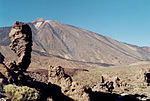
|
Tenerife | Canary Islands | N/A | 1258; 2007; vii, viii | The park contains Mount Teide, a volcano and the highest elevation in Spain. | [11] |
| Works of Antoni Gaudí | 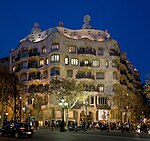
|
Barcelona | Catalonia | 320; 1984, 2005 (extended); i, ii, iv | 19th and 20th centuries | The architecture of Antoni Gaudí is part of the Modernist style, but his designs are described as highly unique. The original listing featured Park Güell, Palau Güell, and Casa Milà; the 2005 extension added Casa Vicens, the crypt and nativity façade of Sagrada Família, Casa Batlló, and the crypt at Colònia Güell. [12] |
United Kingdom[edit]
| Name | Image | Location | Date | UNESCO data | Description |
|---|---|---|---|---|---|
| Blaenavon Industrial Landscape | 
|
Blaenavon, 51°47′N 3°05′W / 51.78°N 3.08°W[13] |
19th century[13] | 984; 2000; iii, iv[13] |
In the 19th century, Wales was the world's foremost producer of iron and coal. Blaenavon is an example of the landscape created by the industrial processes associated with the production of these materials. The site includes quarries, public buildings, workers' housing, and a railway.[13] |
| City of Bath | 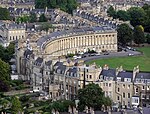
|
Bath, Somerset, 51°22′48″N 2°21′36″W / 51.380°N 2.360°W[14] |
1st–19th centuries[14] | 428; 1987; i, ii, iv[14] |
Founded by the Romans as a spa, an important centre of the wool industry in the medieval period, and a spa town in the 18th century, Bath has a varied history. The city is preserved for its Roman remains and Palladian architecture.[14] |
| Cornwall and West Devon Mining Landscape | 
|
Cornwall and Devon, 50°08′N 5°23′W / 50.13°N 5.38°W[15] |
18th and 19th centuries[15] | 1,215; 2006; ii, iii, iv[15] |
Tin and copper mining in Devon and Cornwall boomed in the 18th and 19th centuries, and at its peak the area produced two-thirds of the world's copper. The techniques and technology involved in deep mining developed in Devon and Cornwall were used around the world.[15] |
| Great Spas of Europe | 
|
Bath, Somerset, (Transnational property) |
1st–20th centuries[16] | 1613; 2021; ii, iii[16] | |
| Gorham's Cave Complex | 
|
East face of the Rock of Gibraltar, 36°07′13″N 5°20′31″W / 36.120397°N 5.342075°W[17] |
33-23 thousand years ago[18] | 1500; 2016; iii[17] |
Comprising four natural sea caves, the complex is the last known site of Neanderthal inhabitation some 28,000 years ago. Evidences of occupation by modern humans are also present at the site.[17] |
| Ironbridge Gorge | 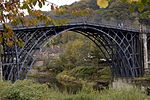
|
Ironbridge, Shropshire, 52°37′34″N 2°29′10″W / 52.626°N 2.486°W[19] |
18th century[19] | 371; 1986; i, ii, iv, vi[19] |
Ironbridge Gorge contains mines, factories, workers' housing, and the transport infrastructure that was created in the gorge during the Industrial Revolution. The development of coke production in the area helped start the Industrial Revolution. The Iron Bridge was the world's first bridge built from iron and was architecturally and technologically influential.[19] |
| Jurassic Coast | 
|
Dorset and Devon, 50°42′N 2°59′W / 50.70°N 2.98°W[20] |
n/a | 1029; 2001; viii[20] |
The cliffs that make up the Dorset and Devon coast are an important site for fossils and provide a continuous record of life on land and in the sea in the area since 185 million years ago.[20] |
| Palace of Westminster and Westminster Abbey including Saint Margaret's Church | 
|
Westminster, Greater London, England 51°29′59″N 0°07′43″W / 51.499722°N 0.128611°W[21] |
10th, 11th, and 19th centuries[21] | 426; 1987 (modified in 2008); i, ii, iv[21] |
The site has been involved in the administration of England since the 11th century, and later the United Kingdom. Since the coronation of William the Conqueror, all English and British monarchs have been crowned at Westminster Abbey. Westminster Palace, home to the British Parliament, is an example of Gothic Revival architecture; St Margaret's Church is the palace's parish church, and although it pre-dates the palace and was built in the 11th century, it has been rebuilt since.[21][22][23] |
| Royal Botanic Gardens, Kew | 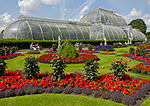
|
Kew, Greater London, 51°28′26″N 0°17′42″W / 51.474°N 0.295°W[24] |
18th–20th centuries[24] | 1,084; 2003; ii, iii, iv[24] |
Created in 1759, the influential Kew Gardens were designed by Charles Bridgeman, William Kent, Capability Brown, and William Chambers. The gardens were used to study botany and ecology and furthered the understanding of the subjects.[24] |
| Tower of London | 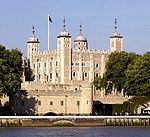
|
Tower Hamlets, Greater London, England 51°30′29″N 0°04′34″W / 51.508056°N 0.076111°W[25] |
11th century[25] | 488; 1988; ii, iv[25] |
Begun by William the Conqueror in 1066 during the Norman conquest of England, the Tower of London is a symbol of power and an example of Norman military architecture that spread across England. Additions by Henry III and Edward I in the 13th century made the castle one of the most influential buildings of its kind in England.[25] |
References[edit]
- ^ "Fortress of Suomenlinna". UNESCO. Retrieved 20 October 2011.
- ^ "Þingvellir National Park". UNESCO. Retrieved 20 October 2011.
- ^ "Alhambra, Generalife, and Albayzin". UNESCO. Retrieved September 15, 2010.
- ^ "Burgos Cathedral". UNESCO. Retrieved September 15, 2010.
- ^ "Garajonay National Park". UNESCO. Retrieved September 15, 2010.
- ^ "Old City of Salamanca". UNESCO. Retrieved September 15, 2010.
- ^ "Importancia Historica" (in Spanish). Salamanca Patrimonio. Retrieved September 15, 2010.
- ^ "Old Town Segovia and its Aqueduct". UNESCO. Retrieved September 15, 2010.
- ^ "Cultural Landscape of the Serra de Tramuntana". UNESCO. Retrieved July 23, 2012.
- ^ "Cathedral, Alcazar, and Archivo de Indias in Sevilla". UNESCO. Retrieved September 15, 2010.
- ^ "Teide National Park". UNESCO. Retrieved September 17, 2010.
- ^ "Works of Antoni Gaudi". UNESCO. Retrieved September 15, 2010.
- ^ a b c d City of Bath, UNESCO, retrieved 29 July 2009
- ^ a b c d Cornwall and West Devon Mining Landscape, UNESCO, retrieved 2009-08-12
- ^ a b Great Spas of Europe, UNESCO, retrieved 25 July 2021
- ^ a b c Gorham's Cave Complex, UNESCO, retrieved 2016-07-15
- ^ Finlayson C, Pacheco FG, Rodríguez-Vidal J, et al. (October 2006). "Late survival of Neanderthals at the southernmost extreme of Europe" (PDF). Nature. 443 (7113): 850–3. Bibcode:2006Natur.443..850F. doi:10.1038/nature05195. PMID 16971951. Archived from the original (PDF) on 2008-08-27.
- ^ a b c d Ironbridge Gorge, UNESCO, retrieved 27 July 2009
- ^ a b c Dorset and East Devon Coast, UNESCO, retrieved 2009-07-29
- ^ a b c d Westminster Palace, Westminster Abbey and Saint Margaret's Church, UNESCO, retrieved 2009-08-15
- ^ History, Westminster Abbey, retrieved 2009-08-15
- ^ Thornbury (1878), p. 567.
- ^ a b c d Royal Botanical Gardens, Kew, UNESCO, retrieved 2009-07-28
- ^ a b c d Tower of London, UNESCO, retrieved 2009-07-28

